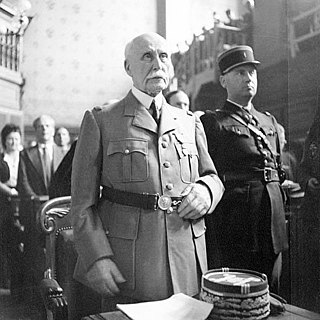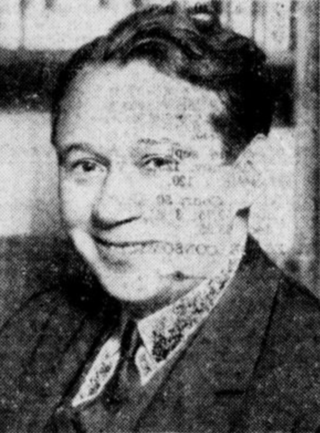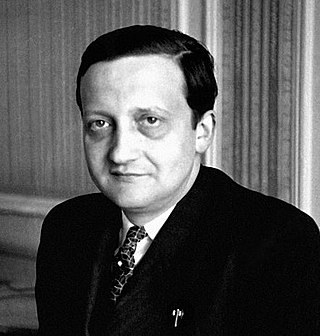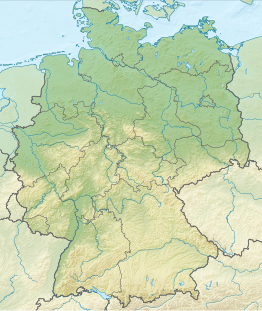
Henri Philippe Benoni Omer Pétain, commonly known as Philippe Pétain or Marshal Pétain, was a general who commanded the French Army in World War I and became the head of the collaborationist regime of Vichy France, from 1940 to 1944, during World War II.

Sigmaringen is a town in southern Germany, in the state of Baden-Württemberg. Situated on the upper Danube, it is the capital of the Sigmaringen district.

Pierre Jean Marie Laval was a French politician. During the Third Republic, he served as Prime Minister of France from 1931 to 1932 and from 1935 to 1936. He again occupied the post during the German occupation, from 1942 to 1944.

Marcel Déat was a French politician. Initially a socialist and a member of the French Section of the Workers' International (SFIO), he led a breakaway group of right-wing Neosocialists out of the SFIO in 1933. During the occupation of France by Nazi Germany, he founded the collaborationist National Popular Rally (RNP). In 1944, he became Minister of Labour and National Solidarity in Pierre Laval's government in Vichy, before escaping to the Sigmaringen enclave along with Vichy officials after the Allied landings in Normandy. Condemned in absentia for collaborationism, he died while still in hiding in Italy.
Lisette, Marquise de Brinon was best known as the Jewish wife of the pro-Nazi French collaborator, Fernand de Brinon.

Fernand de Brinon, Marquis de Brinon was a French lawyer and journalist who was one of the architects of French collaboration with the Nazis during World War II. He claimed to have had five private talks with Adolf Hitler between 1933 and 1937.

The Provisional Government of the French Republic was the provisional government of Free France between 3 June 1944 and 27 October 1946, following the liberation of continental France after Operations Overlord and Dragoon, and lasting until the establishment of the French Fourth Republic. Its establishment marked the official restoration and re-establishment of a provisional French Republic, assuring continuity with the defunct French Third Republic.

The Service d'ordre légionnaire was a collaborationist militia created by Joseph Darnand, a far right veteran from the First World War. Too radical even for other supporters of the Vichy regime, it was granted its independence in January 1943, after Operation Torch and the German occupation of the South Zone, until then dubbed "Free Zone" and controlled by Vichy. Pierre Laval himself passed the law which accorded the SOL its independence and transformed it into the Milice, which participated in battles alongside the Nazis against the Resistance and committed numerous war crimes against civilians. After the Liberation, some members of the Milice escaped to Germany, where they joined the ranks of the SS. Those who stayed behind in France faced either drumhead courts-martial, generally followed by summary execution, or simple lynching at the hands of résistants and enraged civilians.

The épuration légale was the wave of official trials that followed the Liberation of France and the fall of the Vichy regime. The trials were largely conducted from 1944 to 1949, with subsequent legal action continuing for decades afterward.
Anti-Jewish laws were enacted by the Vichy France government in 1940 and 1941 affecting metropolitan France and its overseas territories during World War II. These laws were, in fact, decrees of head of state Marshal Philippe Pétain, since Parliament was no longer in office as of 11 July 1940. The motivation for the legislation was spontaneous and was not mandated by Germany. These laws were declared null and void on 9 August 1944 after liberation and on the restoration of republican legality.

The Révolution nationale was the official ideological program promoted by the Vichy regime which had been established in July 1940 and led by Marshal Philippe Pétain. Pétain's regime was characterized by anti-parliamentarism, personality cultism, xenophobia, state-sponsored anti-Semitism, promotion of traditional values, rejection of the constitutional separation of powers, modernity, and corporatism, as well as opposition to the theory of class conflict. Despite its name, the ideological policies were reactionary rather than revolutionary as the program opposed almost every change introduced to French society by the French Revolution.
Jean Luchaire was a French journalist and politician who became the head of the French collaborationist press in Paris during the German military occupation. Luchaire supported the Révolution nationale declared by the French Government after it relocated to the spa town of Vichy in 1940.

The National Popular Rally was a French political party and one of the main collaborationist parties under the Vichy regime of World War II.

Georges Suarez, was a French writer, essayist, journalist, and jurist. Initially a pacifist during the rise of Nazi Germany, and later a right-wing journalist and collaborator. He had been editor of Aujourd'hui, a French newspaper controlled by the Third Reich after the resignation of the writer Henri Jeanson. Suarez was also the biographer of Philippe Pétain, and other figures of the French Third Republic. He was the first journalist sentenced to death during the Épuration légale.

Vichy France, officially the French State, was the French rump state headed by Marshal Philippe Pétain during World War II. It was named after its seat of government, the city of Vichy. Officially independent, but with half of its territory occupied under the harsh terms of the 1940 armistice with Nazi Germany, it adopted a policy of collaboration. Though Paris was nominally its capital, the government established itself in the resort town of Vichy in the unoccupied "free zone", where it remained responsible for the civil administration of France as well as its colonies. The occupation of France by Nazi Germany at first affected only the northern and western portions of the country, but in November 1942 the Germans and Italians occupied the remainder of Metropolitan France, ending any pretence of independence by the Vichy government.

Jacques Michel Gabriel Paul Benoist-Méchin was a French far right politician and writer. He was born and died in Paris. Well known as a journalist, he later became prominent for his collaborationism under the Vichy regime. After his conviction in 1947 and release in 1954, in the second part of his life he became a historian, with a focus on the Arab world, and in 1981 won the Prix Broquette-Gonin.

Jean Bichelonne was a French businessman and member of the Vichy government that governed France during World War II following the occupation of France by Nazi Germany.

Radio nationale, commonly called Radio-Vichy, was a radio station operated by the Vichy government of France between 6 July 1940 and 26 August 1944.

The Government of Vichy France was the collaborationist ruling regime or government in Nazi-occupied France during the Second World War. Of contested legitimacy, it was headquartered in the town of Vichy in occupied France, but it initially took shape in Paris under Marshal Philippe Pétain as the successor to the French Third Republic in June 1940. The government remained in Vichy for four years, and fled into exile to Germany in September 1944 after the Allied invasion of France. It operated as a government-in-exile until April 1945, when the Sigmaringen enclave was taken by Free French forces. Pétain was brought back to France, by then under control of the Provisional French Republic, and put on trial for treason.

The liberation of France in the Second World War was accomplished through diplomacy, politics and the combined military efforts of the Allied Powers, Free French forces in London and Africa, as well as the French Resistance.


















